
November 13, 2014 – Our drive from Villarino’s to Fidel’s on Day 3 to the beach was uneventful other than lots of traffic and a few Motorcyclists testing the margins of safety. Shortly after climbing the hill southbound from the Santo Tomas Valley we encountered new widened road, almost complete in most sections all the way to Colonet (as I recall), certainly past the Military Checkpoint adjacent to the LA Cetto Vineyards. After a couple of body breaks we had our last stop for fuel just before we set up at our destination, Fidel’s. The gang really enjoyed our ocean side location, meeting Fidel, our two (2) campfires, walking, jogging and cycling on the endless beach, some cycling, jogging and yes for the braver souls boogey boarding and frolicking in the sea. Congratulations to Chris, Andrea and David for exhibiting the real Baja Spirit. Fidel was kind enough to bring Pismo Clams to the Weiner Roast, most everyone tried at least one, and they sure were interesting, certainly much better than the Mussel experience a few years ago.
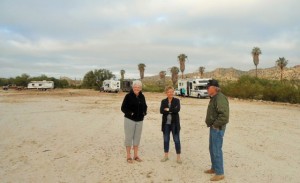
Catavina was next and we were off the next morning on our way to the high desert in the middle of Baja. As expected the drive was with less traffic, a few semis and some Baja Race team members but not bad. Had our usual stop at km 85 then the Onyx Café and a short hello to Lisa, Luis and the kids. We arrived on schedule in Santa Ines at high noon, then headed off to the Cave Paintings including a short hike. Some folks went for dinner at the Cantina, others took a pass. Our friend Steve from California showed up with his buddy Dave heading north with his new Mulege trailer, great to see him. We had a chit chat with Ralph and his wife, after a small fire thanks to some wood provided by Marianne & Andrea.

The following morning at our new adjusted time (mountain) we headed to Guerrero Negro, BCS. The Baja Mil started today however we were far enough ahead to be free off most of the traffic associated with the race. We arrived without any incidents, then quickly up the street for Tony’s Tacos, arguably the best on Baja. The group enjoyed this lunchtime snack, some with a cold beer from the corner store. On the move next to the grocery store then back to the Malarrimo RV Park to catch up on WiFi, Showers, perhaps even a siesta. Dinner at six (6) for almost everyone, no one was disappointed, the food excellent as usual. Unfortunately no Salt Tour tomorrow, Tony our contact just could not make that happen, oh well, perhaps next time.
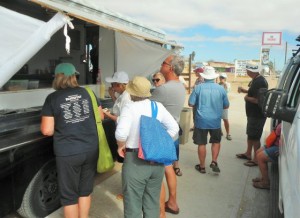

We will leave on Friday at noon to San Ignacio, no point getting there to early, we want as much as possible the Baja 1000 traffic to pass us by. It is jumping Hwy 1 just 35 miles (53 km) south of here, that would be a zoo for sure!
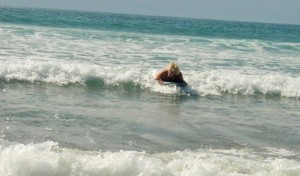 Did you know?
Did you know?
SCORE Baja 1000 (Mil) is an off-road race that takes place on Mexico’s Baja California Peninsula in the third week in November every 2 years. The Baja 1000 is part of the SCORE Championship Desert Racing Series that include the Baja 500, San Felipe 250 and the new San Felipe Challenge of Champions in place of the Primm 300 which had been the only SCORE race in the United States. The Baja 1000 allows various types of vehicle classes to compete on the same course – from such small and large bore motorcycles, stock VW, production vehicles, buggies, Trucks, and custom fabricated race vehicles. The course has remained relatively the same over the years, about every other being either a point-to-point race from Ensenada to La Paz, or a loop race starting and finishing in Ensenada.

The name of the event can be misleading as the mileage varies for the type of event (“Loop” of 600 to 850 miles starting and finishing in Ensenada, or “Point to Point” also known as the of 900 The first official race started in Tijuana, Baja California, on October 31, 1967, and was named the NORRA Mexican 1000 Rally. The course length that year was 849 miles (1,366 km) and ended in La Paz, Baja California Sur, with the overall winning time of 27 hours 38 minutes (27:38) set by Vic Wilson and Ted Mangels while driving a Meyers Manx buggy.
From 1967 to 1972, the race was organized by the National Off-Road Racing Association (NORRA) and grew in popularity with ABC’s “Wide World of Sports” sending Jim McKay to cover the 1968 event, and attracting new participants like the late Mickey Thompson, Indy 500 winner Parnelli Jones and movie actor James Garner. By 1971, major sponsors such as Olympia Brewing Company and Minolta Cameras began to support Parnelli Jones in his Dick Russell designed and Bill Stroppe prepared “Big Oly” Bronco and Larry Minor in a similar Stroppe prepared Bronco. Notably American actor Paul Newman was the oldest participant when he competed in the 2004 event at age 80.[

In October 1973, the price for a barrel of crude oil shot up 70% overnight as the Organization of Petroleum Exporting Countries (OPEC) launched the Arab Oil Embargo. Fearful competitors would abandon the idea of competing and stay home, NORRA abandoned the race – despite assurances from the Federal government run Petroleos Mexicanos (PEMEX) fuel prices would remain stable – and announced they would hold an event in the state of Arizona. It was at that time in history, Baja California governor Milton Castellanos handed over sanctioning of the event to a non-profit Mexican corporation called the “Baja Sports Committee” (BSC). BSC renamed the event the “Baja Mil” (Baja 1000) and scheduled the race to run on the original dates chosen by NORRA. Though NORRA held a competing event in the United States that same weekend, BSC successfully ran the race from Ensenada to La Paz like the years prior. Unaware of the challenges, BSC found promoting Baja races more difficult than anticipated. Instead of giving up the race, the Mexican government requested help from Southern California Off-Road Enterprises (SCORE) in hosting and promoting future Baja races. Through negotiations with Mickey Thompson and his SCORE organization, the Government agreed to give exclusive rights to SCORE to hold Baja races and also reluctantly allowed SCORE to cancel the event for 1974 (a year where motorsport was curtailed in the United States because of the oil crisis). SCORE hired Sal Fish as president and took control of the Baja 1000 from that year on with the Baja 1000 race resuming under new control in 1975. In 2012, the racing organization was purchased by Roger Norman.

History
1962 was the first timed run When Jack McCormack and Walt Fulton of American Honda decided to hold a long-distance run to prove the reliability of Honda’s new CL72 Scrambler, they approached well known off-road dirt biker and local Honda dealer Bud Ekins for suggestions. Bud suggested the Tijuana to La Paz route (Federal Highway 1) which was 950 miles (1,530 km) of rocks, sand washes, dry lake beds, cattle crossing, mountain passes, and paved road. Bud Ekins declined to perform the run because of Triumph Motorcycles ties, but Dave Ekins (Bud’s brother) and Billy Robertson Jr. agreed to perform the trip for American Honda. After doing an aerial pre-run over the peninsula in Fulton’s Cessna 180, they began the journey to La Paz just after midnight on March 22, 1962. While being followed by two journalists in an airplane and using telegraph offices at the Mexican border and in La Paz, Dave Ekins recorded the first official timed run in 39 hours 56 minutes (39:56) with a total distance of 952.7 miles (1,533.2 km). The event received coverage in the Globe, Argosy, and Cycle World magazines, earning awe and respect for Honda and the Baja run. The Globe and Argosy accounts also included close encounters with death and other dangers which Ekins claims were “colorful additions”.

Wanting to beat the existing motorcycle record and to help fuel sales of the Meyers Manx, Bruce Meyers used his original prototype buggy called “Old Red” for an attempt at breaking the record set by Ekins. After pre-running a course south to La Paz, Ted Mangels and Bruce Meyers started the record-breaking attempt back to Tijuana from La Paz at 10:00pm on April 19, 1967. With journalist from Road & Track magazine following the two to witness the attempt, the final official time was 34:45 beating Ekins’ run by more than 5 hours. Upon returning to the United States, the journalist documenting the run sent out press kits with photographs and a news release with the headline “Buggy Beats Bike in Baja.” to hundreds of magazines and newspapers. Soon, more stories of adventure, close calls, and broken speed records received media coverage around the world. Following the event, Bruce Meyers and his Meyers Manx became an overnight sensation and the competition between four wheels and motorcycles for the fastest Baja run began.
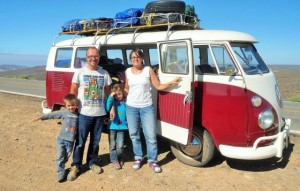
In the following months, more attempts at breaking the record would take place. One of the attempts included a multiple vehicle run organized by Ed Pearlman (Mexican 1000 founder) that ended in an official four-wheel drive record being recorded but with the overall time falling short of the record set by Meyers. On July 4, 1967, an American Motors Rambler American sedan would leave Tijuana at 9:00am to successfully break the record set by Meyers with an overall time of 31 hours.

As the timed runs recorded via telegraph became popular, a need for an organized event to compete for the quickest Baja run was starting to grab the attention of other competitors. Once Ed Pearlman caught word of Meyers’ run, Ed convinced Dick Cepek, Claude Dozier, Ed Orr, Drino Miller and journalist John Lawlor to give a run to La Paz a try. In June 1967, Pearlman and group left Tijuana and immediately ran into mechanical troubles. This trip provided much downtime for Pearlman to brainstorm the idea of the National Off-road Racing Association (NORRA). After Pete Condos and Perlman put up the funds to incorporate NORRA, the group announced an official recognition of the previous record setters and created classes that related to the type of vehicle used to break the record. During the latter part of summer, NORRA named the event the “Mexican 1000 Rally” and announced the first official race from Tijuana to La Paz was to be held on November 1, 1967.

Vehicles
Although motorcyclists participate and are often the overall winners, many competitors drive modified or stock 3 or 4-wheel vehicles such as cars, trucks, ATVs and dune buggies. Race teams consist of factory-supported groups that build custom fabricated vehicles and provide chase vehicles via helicopter, to the much smaller and less glamorized sportsman teams competing in an all-stock vehicle with no chase vehicle support at all. Stock Volkswagen Type One Beetles are modified for use in off-road terrain, known as Baja Bugs, have been a common sight throughout the event duration, but the factory-supported all-space frame Trophy Truck entries are the most visible. In contrast to the current factory EX supported modern race vehicles that overall the car and truck classes, Erik Carlsson drove a basically stock front wheel drive Saab 96 V4, finishing third in 1969 and fifth in 1970.

Baja course
Point-to-point: A point-to-point race is one that starts and ends in two different locations. The start is traditionally held in Ensenada but has been held in Tijuana and Mexicali as well. The course length varies for a point to point but is often over 1,000 miles (1,600 km) and ends in La Paz. Loop race: A loop race is one that starts and finishes in the same location. Traditionally the race starts and ends in Ensenada but has started/finished in Mexicali as well. The course length varies from 600 to 850 miles, depending on the course route.

Sabotage and booby-traps
Each year there are reports of spectators sabotaging or booby-trapping the course by digging holes, blocking river flow, or burying and hiding obstacles. Racers are warned to beware of large crowds of spectators in remote parts of the course since it may indicate hidden traps or obstacle changes. Many of the booby traps are not created to intentionally injure the contestants but are created by the local spectators as jumps or obstacles for spectator entertainment and intriguing moments to be caught on videotape. The haphazardly-designed jumps, created by the spectators, are very dangerous as the contestants may inadvertently enter the booby-trap at unsafe speeds, resulting in damage to the vehicles or injuries to competitors or spectators. Awareness of booby traps and course alterations are often part of race-day strategy and convey an advantage to the best prepared teams — nonetheless given the danger the traps pose, it is customary for competitors to quickly communicate course hazards to other competitors through on-board radio communications and radio relay.
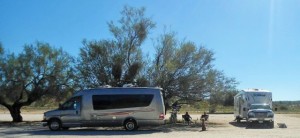
To really appreciate the hazards of this race you just have to see Section 2 of the waiver:

Acknowledgement of Ultra-Hazardous Activity:
I understand, acknowledge and am aware that off-road racing may be a dangerous activity in which a participant could suffer serious bodily, psychological, and neurological injury or death or cause injury to another’s person or property. The possible risks associated with off-road racing include, but are not limited to: (a) the participant being run over, knocked over, thrown or dragged by an automobile, tool or other piece of equipment; (b) the participant being involved in slips, falls, collisions or contacts with other participants, officials, spectators, objects such as gates, vehicles, vehicle parts, tires, pneumatic or other tools, equipment, fences, posts, animals, trees, stakes, signage, flying debris, and other such objects; and intangible things such as fumes and gases in liquid or gaseous form; (c) the participant’s bodily parts being lodged or caught in automobile mechanisms, ropes, wires, hoses, or other equipment; (d) the participant being cut, burned scraped, scratched, bruised or otherwise injured by flying glass, rocks, metal or other substance as a result of an accident, explosion, or fire; (e) the participant’s hearing being temporarily or permanently impaired due to the high levels of noise common to all motor sports events; (f) the participant being injured as a result of hyperventilation, heart attack or panic, due to the physically strenuous activities associated with off-road racing; (g) new injuries or aggravations of existing injuries from equipment failure, misuse or non-use, attempted medical treatment, delays in treatment, emergency evacuations and related efforts or lack thereof.

The 47th Baja Mil is scheduled for November 12th-16th from Ensenada, Baja California to La Paz, Baja California16 Sur (point-to-point, Approx. 1,130 miles), the longest ever.


